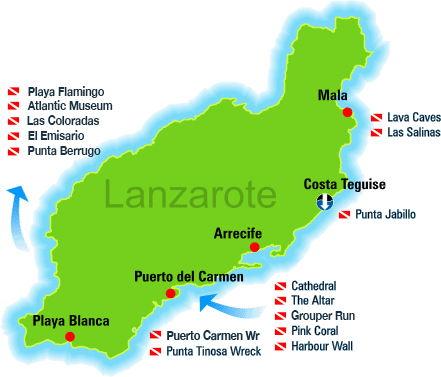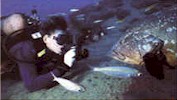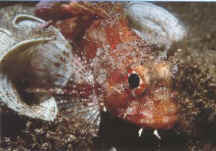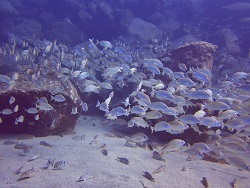Lanzarote Dive Sites :

MALA
Mala – Charco de Palo – This is a very good dive option when there are poor ocean conditions to the southwest. This spot is notable for its purely volcanic rocky landscape, sprinkled with white sand. There is an excellent sample here of many of the Canary ecosystems within a very small space. On the high part, the rocky bottom is covered in a colorful carpet of seaweed. Below 10 m, the Diadema urchin has created extensive urchin-grazed barrens, –rocks without algal covering named in Spanish as “blanquizal”- and the rocks, before they disappear into the fields of sand, tend to form cliffs and caves. Black coral forests only accessible by trained divers grow below 40-50 m.
It is accessed by land. You can get suited up comfortably from the relatively close parking lot and later walk down a path with the equipment and enter the water by one of the two metal staircases.
In Charco de Palo we have Lava Caves and Las Salinas

Mala – Lava Caves – Unique in underwater volcanic lava flows from 15-60 metres in depth. Frequented by a variety of rays such as electric, eagle and butterfly. There is a volcanic island with a cave just off shore where shrimps, goat fish, morays and scorpion fish can be found. Angel sharks frequent this place during the Winter months. A protected bay but the dive site is exposed to the strong winds of the Atlantic Ocean making the site diveable only in very good weather conditions.

Mala – Las Salinas – To the North of the island where the underwater scenery is of rocky lava. The waters here are crystal clear and a little more exposed to the winds so depending on the direction of wind, sometimes this site is not diveable. Rays, morays and the many small fish that like to live among the rocks can be found here.
COSTA TEGUISE

Costa Teguise – Punta JabilloA favourite choice for the complete beginner to experience scuba diving in this protective bay. Many varieties of marine life and the occasional Angel shark.
PUERTO DEL CARMEN
Harbour Wall & Playa Chica – This dive begins in the bay of Playa Chica and gradually leads to a depth of 12 metres. The bay is frequented by numerous divers and the fish are fed so marine life is in abundance. Outside of the bay and leading around to the right is a small harbour wall where cuttlefish, octopus and sea horses can be found. This site is a favourite of novice divers. Also an interesting night dive spot.
Playa Chica is ideal for all types of diving – the shallow areas are perfect decompression stops for advanced divers that want to go down into the depths of the numerous spectacular dives that can be done from this site. Caves, underwater cliffs, volcanic channels, deep water coral, sharks and even unexpected encounters with whales are possible at Playa Chica. This is Lanzarote’s premier dive site.

Cathedral – Entry via the bay of Playa de la Barrilla. Free descent to 16 metres, along the reef to the left and over a drop-off which takes you down to the Cathedral at approximately 30 metres. The Cathedral is a huge, no clear surface cave with alcoves of finger coral and glass fish at the far end. The upper part of the cave is vibrant with soft corals and fauna. This dive is best appreciated with a torch.
The Altar – In the middle of Playa de la Barrilla Bay. This dive commences at the end of the protected bay and is an interesting dive with overhangs on either side where globular anemone, large shrimps and protective arrowhead crabs can be found. Free descent to 10 metres and down to a depth of approximately 25 metres. This is also an interesting night dive spot.
The Grouper Run – A littler further down after the Cathedral and about 35 meters deep we will find an amazing black coral field beside the wall where we could see groupers and barracudas as well as other marine life in the depths.
Pink Coral – Entry via the bay of Playa de La Barrilla. Free descent to 16 metres, along the reef to the right and along a drop-off which leads to one of the rare pieces of pink coral in an alcove of a lava flow. This site has a lot of fish activity in mornings and is visited by trigger fish, fusiliers, barracuda, shoals of sardines and a variety of other small fish.
Shrimp Cave
The dive begins at the Playa Chica stairs or, if we go by boat, at the anchor buoy. From here, you can go down to the foot of the cliff, cross the field of gardener eels, and descend along the impressive wall.
Under 25 – 30 m, the Atlantic damselfish give way to the fairy basslet and sea slugs which begin to appear. The sea slugs have an amazing shape and intense violet color. Upon arriving at the cave, enter carefully and draw close to one of the cavities where the narval shrimp take refuge. Within a few minutes, decompression will be necessary and you will need to begin your ascent, knowing that the shallow area offers us a perfect environment for making our security stop.
Blue Hole – Jump entry from a jetty at high tide with a snorkel swim out to a buoyed anchor line which leads divers down to about 12-14 metres. The reef is followed around to where the Blue Hole commences. The Hole leads down through the reef and out the other side into the deep blue waters of the Atlantic. This dive is from 25-35 metres in depth. Apart from divers this site is visited by great barracuda, grouper and Angel shark. A torch is ideal on this dive to explore the inner caves of the Blue Hole.
Boat Dives @ Puerto del Carmen:
Wrecks Puerto del Carmen – This dive is undertaken by boat and has been designated a marine conservation site and after more than 17 years is now boasting a well established wreck site supporting a vast marine life of sardines, pinfish, turkish wrasse, emperor fish, arrow crabs, large groupers and sometimes visited by large sting rays and tuna (and Angel sharks in the Winter). Wrecks range from a wooden holed wreck at 32 metres up to a clear blue water 18 metres trawler wreck which still has a 2 metres brass propeller intact. There are approximately 8 wrecks together and this site can be dived a few times to explore the whole site.
Wrecks Punta Tiñosa – Two fishing boats have recently been sunk for the purpose of diving. One wreck is in 18 meters of water with the other one in 22 meters. Although new wrecks, the dive is most enjoyable and on a clear day the wrecks can be seen from the surface. A wide variety of marine life can be found on this site.
Waikiki – The dive begins from the anchoring line along the line of buoys that mark off the swimming area. It descends leaving to one side the border of large rocks that extends out towards the coast and, on the other side, a sand slope that goes down to the drop off. We go down the sand to the cliff, following one of the two rock crests depending on the current, which can be strong in this area, and our own preference. At the end of the crest more to the east, at a depth of 18 m under a ledge, grows one of the shallowest branches of orange coral in the Canaries. In the deepest part of the cliff (at about 28 m), to the east, we will find a small cave with a large size hanging encrusting anemone accompanied by fairy basslet.
Richies Place – This dive begins right at the line of buoys that mark the beach swimming area. Once at the bottom, descend down the sand to the small arch formed in the rock that a diver can fit through. From there, follow the cliff leaving it to the right. Just a few meters away, you will come across a placard in honor of Richard, a much loved guide that discovered and made this place popular, and died for reasons other than diving during a vacation abroad.
The landscape is one of the strong points of this dive because of how varied it is. The nooks in the rocks shelter two orange corals and one small cave that is blanketed with narval shrimps. A great variety of other species can also be seen.
The Wall – Descending directly to the cliff to look for life on the giant wall, as well as in the deep blue. In the western part of the cliff, at the bottom, some brightly colored hanging encrusting anemones grow that do not go unnoticed. While exploring the wall, before we know it, the SCUBA computer is telling us it is time to get out of the water. We will ascend to the surface rocks and enjoy the life that bustles there and enjoy the safety stop thanks to the entertainment provided by the biodiversity that shelters there.
No matter how many times we do this dive, it always seems too short. The incredible wall it goes along hides all types of surprises, like brightly colored hanging encrusting anemone, a branch of orange coral, leopard sea slugs or big dusky grouper and trumpetfish that are always aware of our movements. On the wall, at a depth of barely 5 m, a large group of rocks are home to all types of small creatures that can be enjoyed both during the safety stop and while snorkeling.
PLAYA BLANCA

Playa Blanca – Playa Flamingo – After swimming over the man made concrete cubed wall, we drop off to a mix of open sand, ideal for rays and angle sharks, and dramatic lava flows, complemented by the impressive large shoals of fish, such as bream, mullets and jacks. Be sure to have your camera ready!!!
Boat Dives @ Playa Blanca:

Atlantic Museum – The museum is 12 metres deep down pristine waters near the south coast of Lanzarote, in the Bahía de Las Coloradas, a place that was chosen mainly due to the physical characteristics of its sea bottom. It covers a 2,500-square-metre surface that divers and scuba divers will have access to. The museum will be a tourist and cultural attraction.
This museum project will create a huge artificial reef made up of a series of pH neutral cement sculptures which, over time, will help the marine biomass flourish and facilitate the reproduction of species on the island.

Las Coloradas – Two routes are recommended and both have a rock arch in common as a departure point. From here, one alternative is to follow the cliff leaving the wall to the right, while the other route is in the other direction, leaving the wall on the left. The rock formations look like they have been sculpted and are different in each one of the dives. The simplicity and comfort of this dive will not leave experienced divers feeling dissatisfied. It is also interesting for those with less experience because the waters are quite shallow.
El Emisario – The enormous tubes from a submarine outfall, that are lost in the immensity of the platform, serve as a fountain of life and refuge in this strange and well frequented dive. It is, without a doubt, a different place that adds variety to the wide array of options already available in Lanzarote.
The contrast between the rock and the sand gives the opportunity to see species from both environments at a depth less than 20 m. This fact, along with excellent ocean conditions that characterizes the area, offers an especially comfortable dive.
The outfall tubes show the route in and the route out. The area closest to the coast is rock, where the ever present diadema urchin or the striking spider crab thrive.
The rock ends at a small cliff where dusky grouper, moray, island grouper and the majority of fauna that are characteristic of the Canaries reside. The cliff falls down to the sand where it is easy to see angel sharks and stingrays and even those friendly wide-eyed flounder – fish that are obviously related to the bastard sole.
Punta Berrugo – This dive is like searching for hidden treasure. The dive takes place in the space between the sand and the rock, following the small cliff formed there. The rock takes on an artistic formation, creating small spaces that are irresistible to look at in search of inhabitants. The scarce remains of an old wreck that the ocean has almost completely disintegrated can also be seen.
This dive does not have just one route. So that it is easy for us to orient ourselves, the simplest thing to do is leave from the anchoring site and follow the cliff, keeping the rock always to one shoulder. To return to the anchor, you just have to continue along the cliff with the rock over the other shoulder. If desired, you may even visit the wreckage remains. The depth is perfect for diving as most of the swimming is between 12 and 18 m, so a full tank will allow the enjoyment of a relatively long and comfortable dive.
To download a PDF file containing descriptions (in Spanish), photos and maps of all Lanzarote’s dive sites then Click Here
